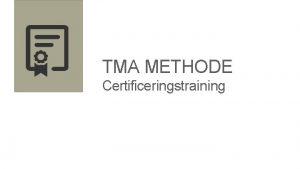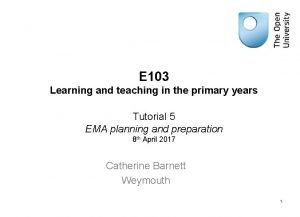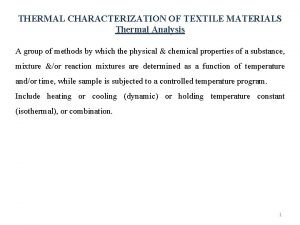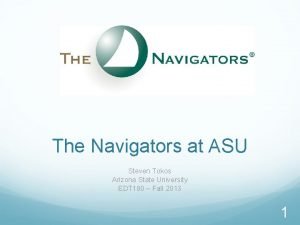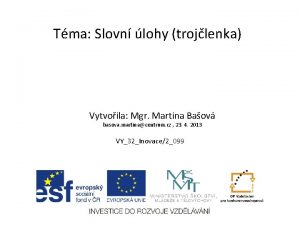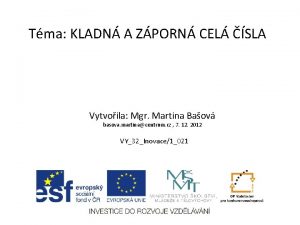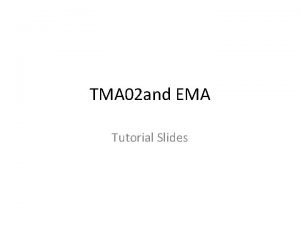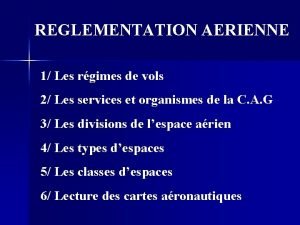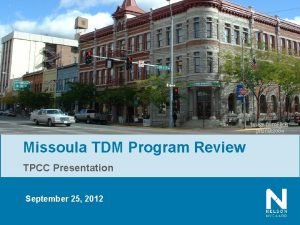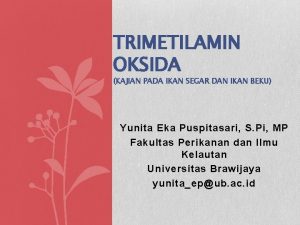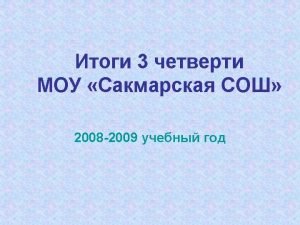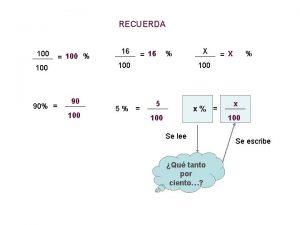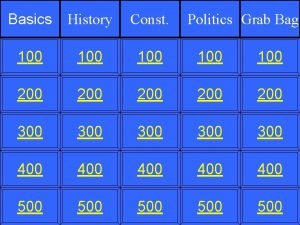TMA 04 Writing the DE 100 Project Report
















- Slides: 16

TMA 04 - Writing the DE 100 Project Report Discussion Section Renee Barclay

Discussion section • Your tutor or Cluster forum will provide you with a sample Results section, which you should use for the purposes of this assignment. • You should on no account base your Discussion on the analysis of data that you and the students from your group collected as part of the DE 100 project work. • Your TMA 04 must be based on the results from data provided by the module team.

Discussion section Tips for writing (1) • In TMA 03 you completed the Method section of the DE 100 project report; • In Online Activity 22. 4: DE 100 Project – Writing the Results section you wrote the Results section or use the Sample Results section provided by the Module team. • In Online Activity 24. 1: DE 100 project – Writing the Introduction, Discussion and Abstract sections you prepared the Introduction. TMA 04 builds directly on this work.

Discussion section Tips for writing (2) • The Discussion should start with a clear statement of the results of your study. So why don’t you start by revisiting the work you did for the Results. Have a go at stating the findings of the study in plain language, and describe what this means. • If you are unsure what else to include in the Discussion, consider the following questions: • • How do the findings compare to those of Chen et al. (2012)? How can the findings be applied beyond the study itself? What are the strengths and limitations of the study? How can this research be taken forward? • Remember to state the word count at the end of your answer.

Activity 1 – Reviewing the Results • Look at the sample Results section • Describe the main findings • What was the hypothesis that was being tested? What was the IV and the DV? • Was the research hypothesis supported or not? • What is the difference between the Null Hypothesis and the Research Hypothesis? • What is meant by significance? Was the difference between those who had the image of happy graduates and the control condition using neutral images, significant or not?

Activity 2 • What did Chen(2012) find in his study? • Do the results of this study support the findings of Chen (2012)? – Explain how this study relates to Chen’s study based on Evaluative conditioning. • You could also relate the findings from this study to Holland’s study on food preferences, which used negative instead of positive associations. • What are theoretical implications of the findings of this study – relate to whether or not the findings of this study support evaluative conditioning.

Write down 3 strengths and 3 limitations of the DE 100 Project Experiment. Strengths of this particular study Limitations of this particular study

How can this research be taken forward? Possible improvements to method Suggestions for further research

What are some practical applications of Evaluative Conditioning?

Conclusions • Conclude your Discussion by making suggestions for further research that could take this study forward. • Give some practical implications of the findings for everyday life.

Part 2 Discussion section Tips for writing (3) • 750 words is not a lot. This means that you may have to be selective about what you include, especially when it comes to strengths and limitations of the study, or ideas about how it can be taken forward. This is why you will probably need to redraft the Discussion several times. Make sure you allow enough time for that. • Finally, your Discussion will be both simpler and shorter than the examples you encountered in Investigating Methods. The key thing to remember is that you need to show that you have understood what writing a Discussion section to a research report involves, and demonstrate your understanding of the DE 100 project.

Part 2 Discussion section Relevant material (1) • Investigating Methods • Chapter 7, Section 3. 3 contains extracts of the Discussion from Bakheit et al. (2007) and outlines the requirements for a Discussion section. • Chapter 8, Section 3 contains extracts from the Discussion section of Nelson et al. (2011). • Chapter 9, Section 3 contains the complete Discussion section of the Loftus and Palmer (1974) study, and Section 4 is also relevant as it summarises the content of a Discussion section, and the different points it needs to cover.

Part 2 Discussion section Relevant material (2) • Online Activities • From Online Activity 24. 1: DE 100 project – Writing the Introduction, Discussion and Abstract sections, you learned that the Introduction and Discussion are not stand-alone entities: they are sections of a report that need to ‘speak’ to each other. Bear this in mind as you write the Discussion. Before you start, you may want to revisit Online Activity 24. 1, and refresh your memory of the Introduction section which you completed as part of that activity. • You may also want to review the DE 100 project online activities in weeks 13 and 15, simply to refresh your memory about the project and its different features. This will be especially useful when you get to write about the strengths and limitations of the study. • Collaborative Activity 8 may also be a useful source of ideas for evaluating the project.

Discussion Checklist • State the results of the experiment in plain language, without citing the actual statistics. Did you find a statistically significant difference between the number of participants who said they liked the DE 100 IPTV logo compared to those in the control condition? Remember to relate this back to the hypothesis and state whether or not it was supported. This is also an opportunity to identify any unexpected results. • Provide an explanation for the results and describe how they compare to other research in the field (as laid out in the Introduction). Do your results support or contradict Chen et al. ’s (2012) findings about the effectiveness of evaluative conditioning. It may help here to revisit Online Activity 13. 4: DE 100 project – Introduction, where the rationale for the DE 100 project is explained. • Explain how the findings could be applied beyond the study. For example, how do they relate to real-life phenomena? At least a sentence should be included about the implications of the current findings with regards to (a) the wider body of literature on evaluative conditioning and (b) its application (e. g. non-celebrity advertising, branding and logos).

Discussion Checklist (2) • Critically evaluate the study, pointing out its limitations and strengths. It is enough to have one or two of each, given the word-limit constraint. Could the results be interpreted in any other way? For strengths, you might consider consistency, controls, the dependent variable or the stimuli. For limitations, you might consider aspects of the study such as the sample size, sampling, the dependent variable or the stimuli. You must also explain why whatever you have identified is a strength or limitation. How might it have affected the meaning, reliability or validity of the results? You may wish to refer back to Collaborative Activity 8 for ideas. Where limitations are identified, try to suggest possible solutions. This can feed into the next point about possible future studies. • Make suggestions for future research. Future research might include adaptations of the same study with a slightly different method to address the limitations you identified in your critical evaluation of the study (see the previous bullet point). Alternatively, you might consider how else participants’ responses could be measured. For example, is there a way of studying their behaviour instead of their verbal responses? • Remember to state the word count at the end of your answer.

Part 2 What your tutor is looking for • Evidence of understanding of the DE 100 project and its strengths and limitations • Accurate interpretation of research findings and their implications • The ability to follow a logical structure appropriate for the Discussion section of a research report • Clear and concise writing and evidence of writing in your own words • The ability to relate the findings to the points made in the Introduction • Referencing of sources • Keeping within the word limit of 750 words. Remember to state the word count at the end of each part of your answer.


